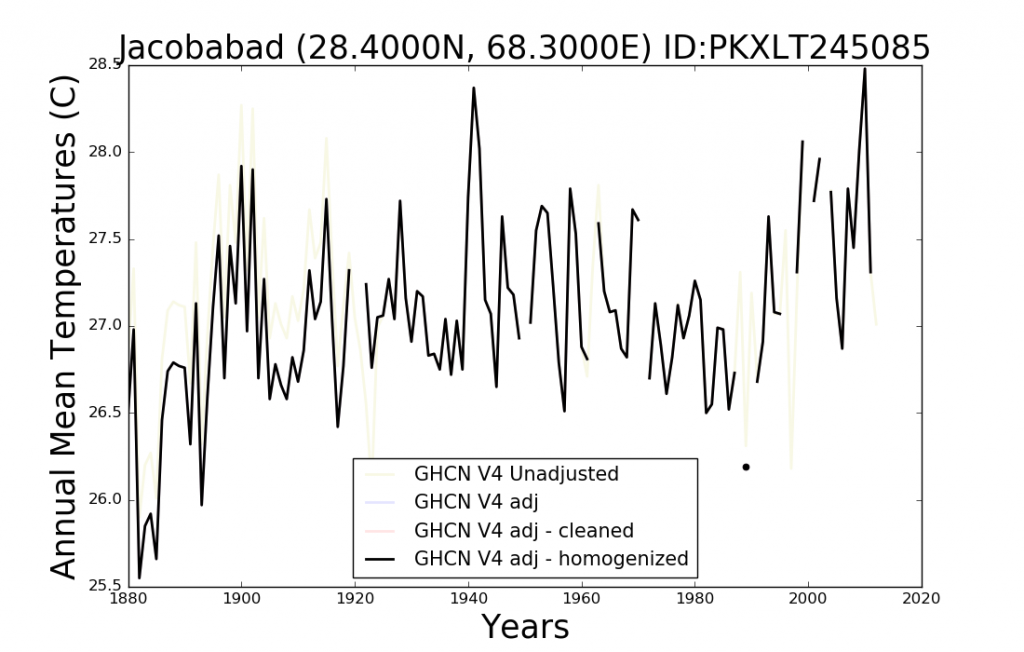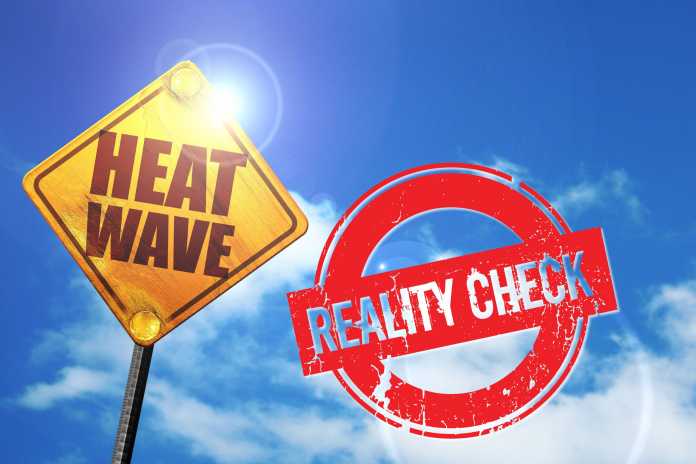A recent article “Reality Check: Are the hottest cities in the world becoming uninhabitable thanks to climate change?” By Dann Mitchell, a professor of climate science at the University of Bristol tries to blame a record heat spike of 51˚C in central Pakistan at the city of Jacobabad on climate change, which is simply incorrect.
He calls that 51˚C (123.8˚F) number “dangerously close to the limit of human survivability. Certainly, that temperature is dangerously close to the limits of human tolerance. Mitchell goes on to talk about another important temperature measure, something called the “wet-bulb temperature”, which is also part of an NBC New scare story about India titled “Deadly ‘wet-bulb temperatures’ are being stoked by climate change and heat waves.”
Mitchell writes:
We actually know the human tolerance level pretty well – it is at 35˚C wet-bulb temperature. At this point humans cannot survive for more than a couple of hours because we can no longer transfer heat from our body to the environment.
That is essentially a metric for the well-known adage “its not the heat, its the humidity.” Humans fare far worse when high temperature and high humidity are combined.
However, Mitchell goes off the rails with this statement:
But will climate change make this worse? Given the increase in temperatures, we expect more exceedances of the 35˚C survivability threshold in the future, but these cases are likely to remain rare and only occur for a few hours at a time. We expect them to be limited to locations in the tropics and subtropics, and even then only during certain years. We predict that the likelihood of these events significantly diminishes if we can adhere to the Paris Agreement climate goals – that is limiting global averaged increases in temperatures to well below 2˚C.
Mitchell purports to be a climate scientist, but he has made two significant errors in his logic related to making climate change the target of blame. First, climate is an average of weather over thirty years, a time period established by the World Meteorological Society (WMO). Any short-term weather event lasting a few hours or days, be it a hurricane, cold snap, or a heat wave is exactly that: weather, not climate.
The other error Mitchell makes is quite egregious. He talks about temperature spikes in the large city of Jacobabad, yet neglects to mention one of the most well-known temperature effects of large cities; the Urban Heat Island effect (UHI).
The University Corporation for Atmospheric Research (UCAR) defines it as:
An urban heat island (UHI) is a metropolitan area which is significantly warmer than its surroundings. According to the EPA, many U.S. cities have air temperatures up to 10°F (5.6°C) warmer than the surrounding natural land cover. This temperature difference usually is larger at night than during the day and larger in winter than in summer, and is most apparent when winds are weak. The main causes are changes in the land surface by urban development along with waste heat generated by energy use.
Clearly, cities excaberate heat wave weather events. Those human symptoms UCAR describes as a result of UHI are the same as those that Mitchell and NBC News want to blame on climate change. According to ZeeNews India, Jacobabad has been well known for its “fierce heat”:
Jacobabad, a city in the Sindh province of Pakistan is known for its fierce heat, but recent research has conferred an unwelcome scientific distinction. The city’s temperature is approximately 52 degrees Celcius which is fatal for a human body.
Apparently it is normal for Jacobabad to be a hot city. The data will tell us.
First, let’s examine the climate history of Jacobabad. Here is a graph (Figure 1) from NASA Goddard Institute for Space Studies (NASA GISS) of the long-term temperature record for the city:

Unfortunately, there is a lot of missing data in the graph, and it is not current to 2022. Missing data is a problem with many third-world countries climate records.
However, even with incomplete data, the graph can tell us three things.
- Between about 1900 and 1990 the temperature record is mostly flat, not increasing. After 1990, there is a sustained increase in temperature.
- Large temperature spikes occurred just after 1940 and near 2012, proving that natural weather events can significantly raise the temperature of Jacobabad, illustrating that heat waves have occured there before.
- Between 1900 and the present, the yearly average temperature of Jacobabad is somewhere between 27 and 28°C (80.6 to 82.4°F).
Clearly Jacobabad is a very warm city, and it has gotten warmer since 1990. But, what has happened in Jacobabad since 1990 that parallels that sustained temperature increase? The answer: Dramatic population increase as seen in Figure 2:

The population growth in Jacobabad parallels the rapid growth for the entire country of Pakistan, as seen in Figure 3:

Population growth in Pakistan (and in Jacobabad) accelerated dramatically in the later part of the 20th century and continues into the 21st. With population growth comes housing and urban development, along with increased energy use. Going back to what UCAR said about UHI, this is pertinent:
“The main causes [of UHI] are changes in the land surface by urban development along with waste heat generated by energy use.”
The temperature data from NASA GISS and the population increases in Jacobabad correlate during that time period. It seems clear that the density of over a million people and their associated infrastructure has had a dramatic effect on temperature in Jacobabad due to the increase in UHI over the last 30-40 years, something that Mitchell and NBC News simply ignored.
UCAR also notes this:
More than half the global population lives in urban areas today and by the year 2050, the percentage of urban dwellers worldwide is expected to reach 70%, so the problem of urban heat islands will continue to grow.
And what of the claim of climate change adding to heat waves in urban places like Jacobabad? According to the citation by Mitchell, “Paris Agreement climate goals – that is limiting global averaged increases in temperatures to well below 2˚C.”, and because the global climate system has already warmed approximately 1 to 1.5C since 1850 (depending on who you ask) it is doubtful that an additional 0.5 to 1˚C on top of that will make a difference in naturally hot cities like Jacobabad.
Rather than blaming climate change, Mitchell would do better to follow the cooling strategies for cities suggested by the U.S. Environmental Protection Agency.
1) increasing tree and vegetative cover, 2) installing green roofs, 3) installing cool—mainly reflective—roofs, 4) using cool pavements (either reflective or permeable), and 5) utilizing smart growth practices.
That list is practical and achievable, even for a poor country like Pakistan.
That’s the reality check Mitchell and NBC News needs to embrace; make the cities cooler by modifying infrastructure rather than trying to control an uncontrollable climate system.



















Dear Anthony, where can I download the temperature data from Jacobabab? I can work on different approaches to impute missing data